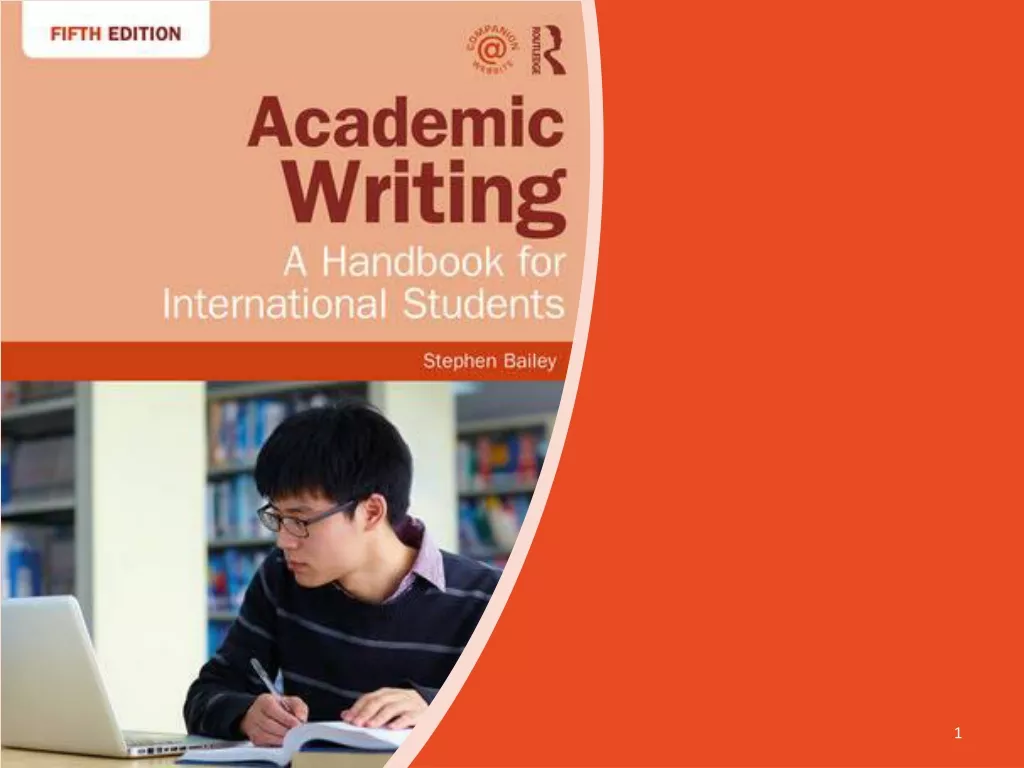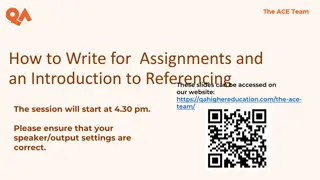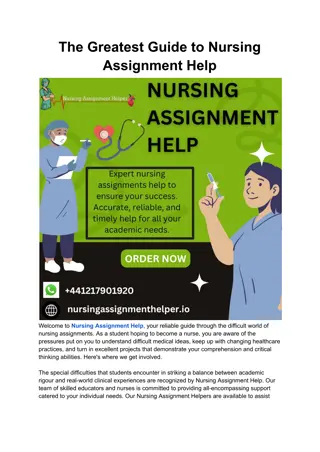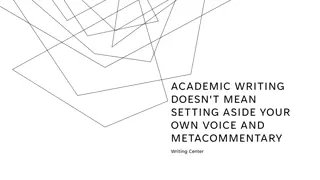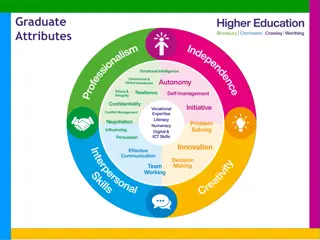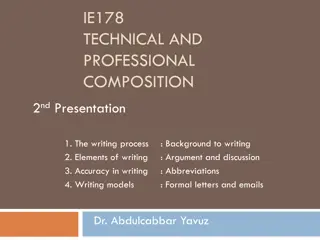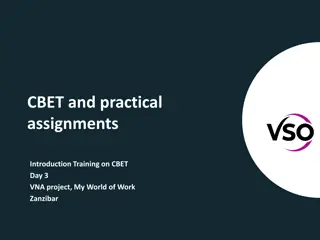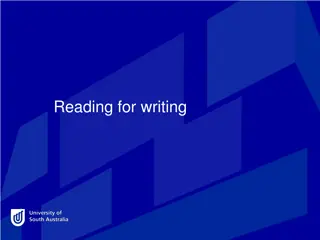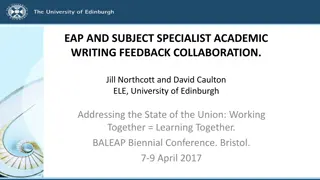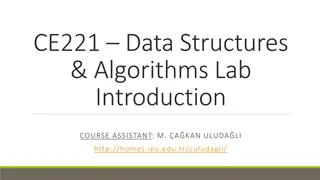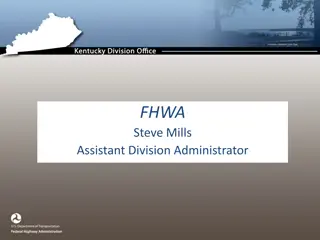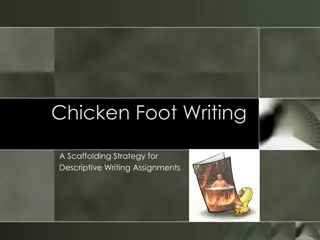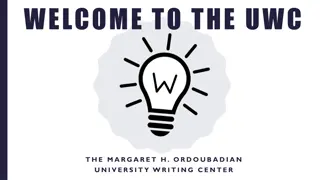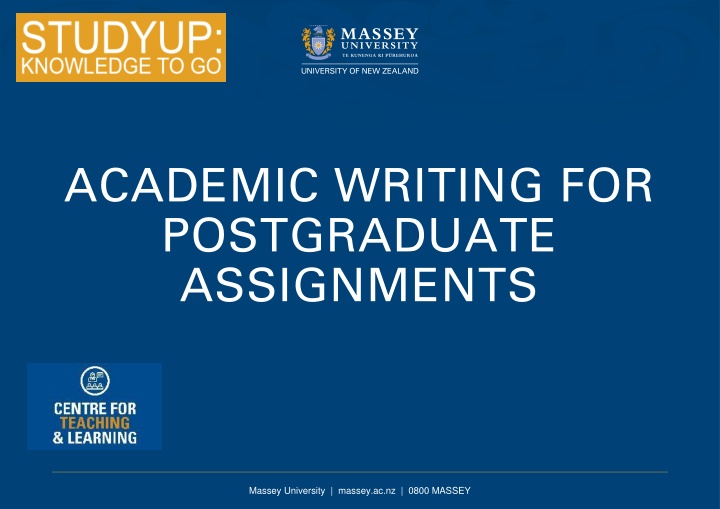
Academic Writing Guide for Postgraduate Assignments at Massey University
Learn academic writing strategies for postgraduate assignments at Massey University including steps for writing an assignment, analyzing assignment questions, note-taking, and essay structure. Get guidance on how to prevent workplace bullying by examining organizational factors critically.
Download Presentation

Please find below an Image/Link to download the presentation.
The content on the website is provided AS IS for your information and personal use only. It may not be sold, licensed, or shared on other websites without obtaining consent from the author. If you encounter any issues during the download, it is possible that the publisher has removed the file from their server.
You are allowed to download the files provided on this website for personal or commercial use, subject to the condition that they are used lawfully. All files are the property of their respective owners.
The content on the website is provided AS IS for your information and personal use only. It may not be sold, licensed, or shared on other websites without obtaining consent from the author.
E N D
Presentation Transcript
STUDYUP: KNOWLEDGE TO GO ACADEMIC WRITING FOR POSTGRADUATE ASSIGNMENTS Centre for Teaching and Learning Massey University | massey.ac.nz | 0800 MASSEY
OVERVIEW Steps for writing an assignment Breaking down assignment questions and identifying tasks Note taking for assignment purposes Reading academic texts Paragraph structure Essay structure Writing introduction paragraphs Writing conclusion paragraphs Massey University | massey.ac.nz | 0800 MASSEY
Steps for writing an assignment? Analyse the assignment question Brainstorm the topic - key questions that need to be answered? Find and choose sources (see how to find information on your topic ) Read and take notes Prepare outline Write first draft and get feedback Edit first draft, second draft, third draft Massey University | massey.ac.nz | 0800 MASSEY
SAMPLE SAMPLE ASSIGNMENT ASSIGNMENT QUESTION QUESTION Assignment 1: Essay Due date: 28 March, 2013 Word limit: 1500 words Learning outcome: 3 Weighting: 20% See CTL workshops & OWLL for other formats See Assignment Planning link on OWLL Keep to the word limit! Use to help you understand assignment requirements Tells you how much this assignment makes up your overall grade In order to prevent workplace bullying, organisations need to look beyond issues of individual personality and examine how underlying organisational factors can contribute to the problem. Critically discuss. Take note! You need to refer to at least 15 academic sources in completing this assignment. Make sure you use this! Recommended source: Griffin, R.W., & Moorhead, G. (2012). Organizational behavior: Managing people and organizations. South Western/Cengage Learning. Massey University | massey.ac.nz | 0800 MASSEY
In order to prevent workplace bullying, organisations need to look beyond issues of individual personality and examine how underlying organisational factors can contribute to the problem. Critically discuss. Step 1: Identify the topic - What is the assignment about (broad topic)? Workplace bullying Massey University | massey.ac.nz | 0800 MASSEY
In order to prevent workplace bullying, organisations need to look beyond issues of individual personality and examine how underlying organisational factors can contribute to the problem. Critically discuss. Step 2: Identify the focus - What do I include on this topic? Organisational factor 1 Workplace bullying Organisational factor 3 Organisational factor 2 Individual personality: Massey University | massey.ac.nz | 0800 MASSEY Bully & victim
In order to prevent workplace bullying, organisations need to look beyond issues of individual personality and examine how underlying organisational factors can contribute to the problem. Critically discuss. Step 3: Identify the command words - What do I have to do in the assignment? Organisational factor 1 Workplace bullying Organisational factor 3 Organisational factor 2 Individual personality: Massey University | massey.ac.nz | 0800 MASSEY Bully & victim OWLL - Interpreting Assignment Questions: http://owll.massey.ac.nz/academic- writing/interpreting-the-assignment-question.php
IDENTIFYING THE TASK Critically discuss Following a statement/quotation, implies judgement. Presenting a critical discussion might include: - Covering competing ideas/perspectives and findings on the topic - Highlighting where researchers agree/disagree? - Pointing out strengths and limitations of suggested ideas - Asking, are there gaps in available research on the topic? For example: - Do you agree or disagree with the statement? Why? - Do you agree partially? Why? Come to a conclusion on the problem. - Does the evidence in the literature support the statement? Massey University | massey.ac.nz | 0800 MASSEY
In order to prevent workplace bullying, organisations need to look beyond issues of individual personality and examine how underlying organisational factors can contribute to the problem. Critically discuss. Does the evidence in the literature support this statement? Brainstorming the topic before you start searching Massey University | massey.ac.nz | 0800 MASSEY
Example: Brainstorming the topic What are the key questions that need answering? What is workplace bullying? Definition(s) Define your concepts Explain significance of problem: Effect on individuals/ organisations/society evidence from literature Why is it a problem? How can individual personality contribute to workplace bullying? Is a focus on these factors sufficient to prevent workplace bullying? Why?/Why not? Which factors? Why? How? Do they work in combination? Can organisational factors contribute to workplace bullying? Given our understanding of the factors, how can workplace bullying be prevented? Are there examples of successful implementation of measures? Massey University | massey.ac.nz | 0800 MASSEY Key words/phrases for Library search?
Finding and using information in readings Finding information in a journal article and taking notes Using your readings to help you write We ll be using extracts adapted from Bentley et al. (2012) in this section Library s list of learning services See Library Classes (face-to-face and online): http://www.massey.ac.nz/massey/research/library/library- Massey University | massey.ac.nz | 0800 MASSEY services/learning-services.cfm
Taking notes for Taking notes for assignments assignments When researching literature, try: Keeping a list of key questions to be answered in front of you - You re searching for relevant information only Taking notes in the margins of journal articles as you read - Summarise relevant ideas - What is the writer doing in the text? Making cross references to other articles note similarities / differences across sources Collecting notes in a document - Keep updating until you have enough information for your assignment Massey University | massey.ac.nz | 0800 MASSEY
Example: Taking notes for your assignment Keep key questions in front of you you re searching for relevant information Key questions Article My notes Definition(s) of workplace bullying Bentley et al. (2012) Tips: Ways of reading - Skim through the article by Bentley et al. to see whether it contains relevant information for our assignment. Look at: the article title the abstract the first paragraph headings subheadings & first sentences under them Using direct quotes - Always write them in double quote marks, and note down the page number, so that they are ready easy to find and cite in your own writing. Significance of problem? Individual factors? Organisational factors? Preventative measures? Also see this online tutorial: Reading & Notetaking for downloadable Massey University | massey.ac.nz | 0800 MASSEY templates.
Structure of research articles Structure of research articles The story structure of research There s this important problem or issue... and researchers understand some areas of the problem but others need more research a specific area requiring more research is this...and it s important because... so what we did was and found that . which means we now know this and the implications of the findings are (Image adapted from Paltridge & Starfield, 2007) Massey University | massey.ac.nz | 0800 MASSEY
Example: Components of a research article Example: Components of a research article Articles generally include: Abstract:Brief summary highlighting reasons for study, methods & findings Introduction: Significance of topic;brief review of theoretical background & earlier research on topic; reasons for current research Method: How research was conducted & materials used Results: Details on findings and statistical tests, with summaries of data in the form of charts/graphs/tables Discussion: Analysis, interpretations, implications of results Conclusion: Summary of key findings, implications for the field and suggestions of future directions for further research Massey University | massey.ac.nz | 0800 MASSEY
Skim through this passage from Bentley et al. (2012, p. 353): Who should be acknowledged as the author of the bulleted points? Massey University | massey.ac.nz | 0800 MASSEY
In order to prevent workplace bullying, organisations need to look beyond issues of individual personality and examine how underlying organisational factors can contribute to the problem. Critically discuss. Sample from an essay on the topic: Another organisational factor linked to workplace bullying is the workplace environment. For example, Bentley et al. (2012) list a number of environmental factors found to be associated with bullying. These include Google: Manchester University + Academic Phrasebank - provides academic phrases to refer to the literature Massey University | massey.ac.nz | 0800 MASSEY
Read through this passage from Bentley et al. (2012, p. 354) In regards to employee selection, one key primary prevention strategy is to use staff selection systems to screen out those with undesirable traits or motives (Blackman & Funder, 2002; Fodchick, 2007; Gardner & Johnson, 2001; Glendinning, 2001) or to select those with desirable qualities such as integrity (Ferris, 2009) or emotional intelligence (Yamada, 2008). However, these approaches need to be treated with care due to their potential for adverse impacts, and all selection methods must be valid and job related. This is how authors demonstrate their critical thinking, propose counter arguments, express notes of caution etc i.e. Express their voice Massey University | massey.ac.nz | 0800 MASSEY
Try not to be intimidated by academic text The negative consequences of bullying for the target are substantial. At the individual level, targets are likely to have lower self-esteem, more negative emotion, anxiety, stress, fatigue, burnout and depression than non-targets (Agervold & Mikkelsen, 2004; Einarsen, Matthiesen, & Skogstad, 1998; Hoel, Faragher, & Cooper, 2004; Lutgen-Sandvik, 2008; Mikkelson & Einarsen, 2002. These negative impacts are not limited to the target of bullying. Indeed, negative health effects have also been found among those who have witnessed bullying but have not been personally targeted (Burnes & Pope, 2007; Hoel et al., 2004; Lutgen-Sandvik et al., 2007). Negative consequences for the organisation are also considerable. Targets of workplace bullying have greater absenteeism, along with reduced job satisfaction, organisational commitment and work motivation (Agervold & Mikkelsen, 2004; Burnes & Pope, 2007; Hallberg & Strandmark, 2006; Loh, Restubog, & Zagenczyk, 2010). Targets are also more likely to leave the organisation (Djurkovic, McCormack, & Casmir, 2004, 2008). Further organisational costs include displaced effort in helping staff cope with bullying incidents, and the costs associated with investigations of ill treatment and potential court action (Rayner & Keashley, 2005). Massey University | massey.ac.nz | 0800 MASSEY
Reading tip: Skip over reference brackets when you read The negative consequences of bullying for the target are substantial. At the individual level, targets are likely to have lower self-esteem, more negative emotion, anxiety, stress, fatigue, burnout and depression than non-targets (Agervold & Mikkelsen, 2004; Einarsen, Matthiesen, & Skogstad, 1998; Hoel, Faragher, & Cooper, 2004; Lutgen-Sandvik, 2008; Mikkelson & Einarsen, 2002). These negative impacts are not limited to the target of bullying. Indeed, negative health effects have also been found among those who have witnessed bullying but have not been personally targeted (Burnes & Pope, 2007; Hoel et al., 2004; Lutgen-Sandvik et al., 2007). Negative consequences for the organisation are also considerable. Targets of workplace bullying have greater absenteeism, along with reduced job satisfaction, organisational commitment and work motivation (Agervold & Mikkelsen, 2004; Burnes & Pope, 2007; Hallberg & Strandmark, 2006; Loh, Restubog, & Zagenczyk, 2010). Targets are also more likely to leave the organisation (Djurkovic, McCormack, & Casmir, 2004, 2008). Further organisational costs include displaced effort in helping staff cope with bullying incidents, and the costs associated with investigations of ill treatment and potential court action Massey University | massey.ac.nz | 0800 MASSEY
Writing academic text Use journal articles in your own discipline as models to help you write academic text in the discipline Requires an examination of the structure and features of academic writing - structuring paragraphs to develop your argument - using and referencing sources Note: Not all literature is well written and not all journal articles use APA Referencing! Massey University | massey.ac.nz | 0800 MASSEY
PARAGRAPH STRUCTURE: RULES OF THUMB Each paragraph should Develop one main idea and be approximately 70 - 150 words The paragraph should have a topic sentence that states the main idea of the paragraph - usually placed in the first sentence of the paragraph The rest of the paragraph should develop the main idea - explanations, reasons, evidence, definitions of terms Use connectors to link sentences and paragraphs and guide the reader through the text Massey University | massey.ac.nz | 0800 MASSEY
One main idea per paragraph Negative consequences for the organisation are also considerable. Targets of workplace bullying have greater absenteeism, along with reduced job satisfaction, organisational commitment and work motivation (Agervold & Mikkelsen, 2004; Burnes & Pope, 2007). Targets are also more likely to leave the organisation (Djurkovic, McCormack, & Casmir, 2004, 2008). Further organisational costs include displaced effort in helping staff cope with bullying incidents, and the costs associated with investigations of ill treatment and potential court action (Rayner & Keashley, 2005). Topic sentence - main idea Supporting ideas: Examples Evidence Use appropriate connecting words and phrases for: additional points (also; in addition; furthermore) contrasting points (in contrast; however; while) result(s) of something (as a result) cause of something (one possible reason; one contributing factor Massey University | massey.ac.nz | 0800 MASSEY
Using `this to link sentences and paragraphs Some common words to make the reference back clearer and form a bridge to your developing argument: For things that happen: For things that are done: For views: idea incident action view event move attitude situation reaction perception circumstances behaviour perspective development practice (Adapted from Pakenham, 2001) Massey University | massey.ac.nz | 0800 MASSEY
WRITING AN ESSAY What is an essay? An essay is an extended, written response to a particular question that outlines the author s position. Where the author stands on an issue Massey University | massey.ac.nz | 0800 MASSEY
Your voice guides the argument throughout the essay You present your position on the topic, using evidence to back up your statements/claims/arguments Introduction Introduce issue State your position Body paragraphs Defend your position Each paragraph = evidence based argument Conclusion Restate your position Summarise points of your argument Massey University | massey.ac.nz | 0800 MASSEY
https://encrypted-tbn3.gstatic.com/images?q=tbn:ANd9GcQQC535bhY-cNuer_k00RvsTSXzoEcf9YIkZ9FafF3mq6bugML-xAhttps://encrypted-tbn3.gstatic.com/images?q=tbn:ANd9GcQQC535bhY-cNuer_k00RvsTSXzoEcf9YIkZ9FafF3mq6bugML-xA Essay structure Set up the context for your topic Tell the reader about your focus in the essay and what will be included Introduction 10-15% Each body paragraph delivers on what s been promised one main idea per paragraph usually expressed in first sentence (topic sentence) support main idea with evidence from literature connect sentences and paragraphs Anchor each paragraph to the introduction by repeating key words in topic sentences Come to a logical conclusion summarise main ideas look to the future - significance of what you ve found Conclusion 10% Massey University | massey.ac.nz | 0800 MASSEY
Preparing an outline for an essay Assignment topic In order to counteract workplace bullying and prevent future incidents, organisations need to look beyond issues of individual personality and examine how underlying organisational factors can contribute to the problem. Critically discuss. 1500 words Average words per paragraph = 150 - 200 So for this essay, start off with a rough plan for ... 10 or 11 paragraphs Massey University | massey.ac.nz | 0800 MASSEY
A plan for this essay might look like this Paragraph sequence: 1: Introduction: prevalence of workplace bullying; definition of bullying; consequences of bullying: individual & organisational 2: Current policies & practice often focus on issues with individual employees but research shows organisational factors also very important 3/4 : Factors with individual employees What is the issue? Why is it a problem? What interventions can be used address it? Strengths/limitations of interventions? 5/6 : Organisational factor 1 7/8 : Organisational factor 2 9/10: Organisational factor 3 11: Conclusion: combination of interventions needed to address complex problem; future research and practice Massey University | massey.ac.nz | 0800 MASSEY
Introduction: Narrowing down to specific focus and thesis statement General topic area Significance of problem or issue Definition of concept from academic source Prevalence of workplace bullying Consequences of workplace bullying Formal definition of workplace bullying Policy and practice in organisations often focus on issues with individual employees BUT Specific focus Focus in this essay? Why this specific focus? Research has identified organisational factors associated with increased risk of bullying SO Thesis statement Main point / argument / position Organisations need to understand these factors in order prevent bullying Essay map What are you going to do in the essay? (Indication of structure) Essay discusses four main factors & critically examines measures to address them Massey University | massey.ac.nz | 0800 MASSEY
Thesis statement examples Possible examples: Issues with individual employees cannot be ignored in any attempt to analyse and address an organisation s problem with workplace bullying. However, it is crucial that the organisation also recognises and addresses organisational factors (A, B, C and D), which may be enabling and even encouraging bullying behaviour. Or This essay argues that while issues with individual employees cannot be ignored in addressing workplace bullying, organisations need to recognise and understand the significant role played by organisational factors in enabling and even encouraging workplace bullying. Four major organisational factors will be discussed, including A,B,C and D More examples: http://www.indiana.edu/~wts/pamphlets/thesis_statement.shtml Massey University | massey.ac.nz | 0800 MASSEY
When do you refer to literature? 1: Introduction: prevalence of workplace bullying; definition of bullying; consequences of bullying: individual and organisational. Thesis statement 2/3: Factors with individual employees 4/5: Organisational factor 1 6/7: Organisational factor 2 8/9: Organisational factor 3 10: Conclusion: combination of interventions needed to address complex problem; future research and practice Massey University | massey.ac.nz | 0800 MASSEY
The Conclusion Restate thesis; Summarise main points made in argument Succinctly written Don t draw conclusions about something you haven t discussed in essay Look to the future: application of what you ve found; further research Massey University | massey.ac.nz | 0800 MASSEY needed on topic
CENTRE FOR TEACHING AND LEARNING Need help? We have a range of free services to help you with your assignment writing and study skills: Individual Support: Want to discuss your assignment before you hand it in? Want to discuss study skills (e.g. how to manage time)? See next slide for booking information. Pre-Reading Service: Submit a draft assignment and receive individual written feedback on your assignment s structure, focus, referencing, and use of sources. This service is available to first year internal and all distance students. You can access the forum through the Academic Writing and Learning Support site on your Stream homepage. Workshops: Seminars and workshops are run on campus and online, which can help you with writing and study skills, such as essay writing, referencing, and writing research proposals. See here for programmes and registration details. See http://owll.massey.ac.nz/about-OWLL/workshops.php Academic Q+A forum: Ask our consultants a question about academic writing and/or study skills. The Q & A forum is a place for students to receive help with quick, study-related questions. You can access the forum through the Academic Writing and Learning Support site on your Stream homepage. OWLL: Information about academic writing and study skills, including assignment planning, essays, reports, and referencing. Go to http://owll.massey.ac.nz/index.php Disability Services: A range of services and support for students who have health and disability issues that are impacting their study. Pasifika@Massey: Whether studying as an internal or distance student, you can also access Learning support from the Pasifika Learning Advisors. Te Rau Tauawhi: Ko t Te Rau Tauawhi he whina i ng tauira M ori ki te tuku aromatawatai ki Te Reo M ori, ki te tautoko hoki i ng huatanga whakarite tuhinga. The Te Rau Tauawhi M ori Student Centre can help you to submit your assignment in Te Reo M ori and provide general assignment structure support. Massey University | massey.ac.nz | 0800 MASSEY
MASSEY UNIVERSITY CENTRE FOR TEACHING & LEARNING http://ctl.massey.ac.nz/ CAMPUS LOCATIONS: Palmerston North - Manawatu: Centre for Teaching and Learning Student Centre Level 2, Manawatu Campus Phone: + 64 6 951 6540 Email: ctlman@massey.ac.nz We help students with Assignment writing advice Albany: Centre for Teaching and Learning Level 3, Library, Albany Campus Phone: + 64 9 212 7117 Email: ctlalb@massey.ac.nz Academic writing development Understanding assignment questions Citing and writing references Enhancing study skills, like: Wellington: Centre for Teaching and Learning Block 5, Ground Floor (Level A in the Library), Wellington Campus Phone: +64 4 801 5799 extn: 63389 Email: ctlwel@massey.ac.nz Reading techniques Notetaking Time management skills Critical thinking, reading & writing TO BOOK AN APPOINTMENT, GO TO: https://massey-nz.libcal.com/

